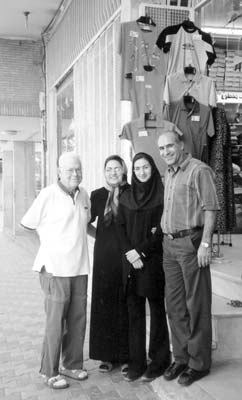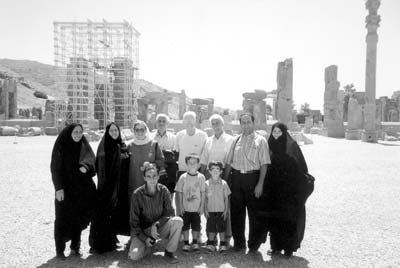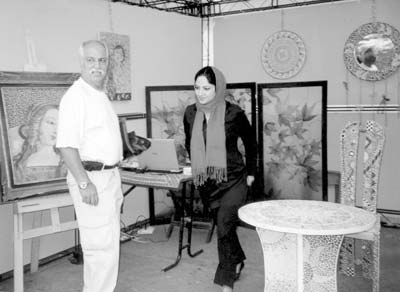“Essential Iran” tour with MIR Corp.
My husband, Dick, and I took the “Essential Iran” tour with MIR Corp. (85 South Washington St., Ste. 210, Seattle, WA 98104; 800/424-7289, www.mircorp.com), Sept. 8-17, 2006, and thought ITN readers might be interested in the observations of two ordinary American tourists, a rarity there.
We paid about $2,400-$2,500 each, including flights Tehran-Shiraz-Isfahan-Tehran. In 2007, the 10-day trip costs $2,795 per person for two to 16 travelers.
Our “tour group” consisted of only the two of us plus an Iranian guide. Interestingly, he was a graduate of Marshall University in West Virginia and had a sister living in Richmond, a niece in the U.S. Navy and a cousin teaching at Marshall. We met several Iranian-Americans there who were visiting family.
We had a very flexible schedule and could go to places where a large group could not be accommodated. We spent time in Tehran, Isfahan and Shiraz as well as Persepolis.
We had no problem with airport formalities — no fingerprinting or forms to fill out. The officials were always polite, even friendly. When leaving, we wanted to keep our luggage cart through Customs and Immigration all the way to the gate. The “controller” of the carts said this was not allowed, but the Immigration officer said, “These are our guests and they can keep the cart.”
We learned that American English is still taught in Iran’s schools as the link to the West. Many street signs in Tehran are in both Farsi and English, and artifacts in museums are tagged in both languages.
While there are many interesting historical sights and first-class museums in Iran, in this report we will concentrate on our people-to-people encounters.
Since we were speaking English as we toured various sights, including mosques, people often came up to us to find out who we were. There was never the slightest hostility toward us Americans. We had several encounters where people wanted our photos taken with their families (quite a switch for a tourist!).
In Shiraz, a middle-aged man with his wife, sons and daughters came up to us and wanted to let us know how much they appreciated our coming to Iran to see and learn about their country. He worked in the government and his wife was a teacher.
We had a chat with two young ladies, college students studying architecture. They showed us several of their sketches and projects. Iran’s is no Taliban-type regime.
When we were looking into the window of a children’s clothing store, the owner, his wife and their teenage daughter came out to greet us. The wife spoke English well, having learned it in technical school. This was the only time we got into any political discussions. The gist of it — if both our presidents would keep their mouths shut, the world would be a better place.
This family said they have satellite TV and watch Voice of America, among other Western programs. The reason we had stopped to look in the store window was because we saw a T-shirt with a Spider-Man figure on the front. We discovered that the Iranians learn about America and its culture from the Internet, satellite TV, videos and movies, so Spider-Man was picked up by the kids. The T-shirts were made in Iran.
We also saw American-packaged and -canned foods in the grocery stores. We were told they had to “launder” them through a third country because of U.S. sanctions, but obviously they had not been stopped from entry by the Iranian government.
Many of the urban youth seem to be pushing the dress code as far as they can. For them, black is out. Women’s head scarves in bright colors were pushed back on their heads so the hair was showing — sometimes streaked with blond coloring. Heavy eye makeup, bright lipstick, painted nails, tighter-than-normal pants and shorter jackets were not uncommon. Holding hands in public also occurs.
Since we were able to go where we chose, we wanted to find out about religious tolerance. In Isfahan we explored a 1,000-year-old part of the city where Moslems and Jews have lived side by side “forever.” Most of the Jewish community has migrated to Israel, but about 3,000 remain.
We could not get into the main synagogue there, as it was locked and our guide couldn’t find the person with the key; it was open only at times of worship. However, we were able to go into a very small 100-year-old synagogue. There is no rabbi there, so prayers are said by individuals. We were assured by the Jews present that they were free to practice their religion without discrimination and that they conducted their small businesses while living in this mixed community.
We went across the river which bisects Isfahan and spent some time with the Armenian community, which, to our observation, also was free of religious and social interference.
Note: most, if not all, of the people we had conversations with spoke English, so they were the members of the educated urban middle class, but we walked through city streets, squares and bazaars and into shops and even mosques speaking English without encountering a bit of hostility. Several times, teenage boys would zip past calling out greetings, simply demonstrating their knowledge of English.
BETTY PODOL
Reston, VA



